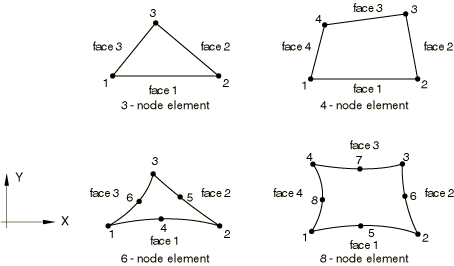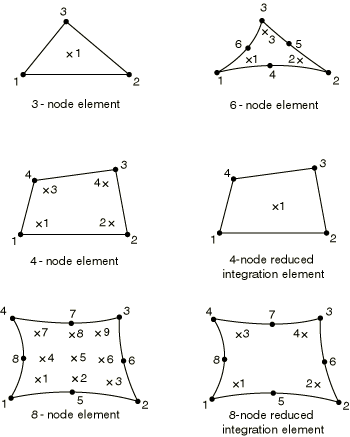Element Types
Plane Strain Elements
- CPE3
-
3-node linear
- CPE3H(S)
-
3-node linear, hybrid with constant pressure
- CPE4(S)
-
4-node bilinear
- CPE4H(S)
-
4-node bilinear, hybrid with constant pressure
- CPE4I(S)
-
4-node bilinear, incompatible modes
- CPE4IH(S)
-
4-node bilinear, incompatible modes, hybrid with linear pressure
- CPE4R
-
4-node bilinear, reduced integration with hourglass control
- CPE4RH(S)
-
4-node bilinear, reduced integration with hourglass control, hybrid with constant pressure
- CPE6(S)
-
6-node quadratic
- CPE6H(S)
-
6-node quadratic, hybrid with linear pressure
- CPE6M
-
6-node modified, with hourglass control
- CPE6MH(S)
-
6-node modified, with hourglass control, hybrid with linear pressure
- CPE8(S)
-
8-node biquadratic
- CPE8H(S)
-
8-node biquadratic, hybrid with linear pressure
- CPE8R(S)
-
8-node biquadratic, reduced integration
- CPE8RH(S)
-
8-node biquadratic, reduced integration, hybrid with linear pressure
Active Degrees of Freedom
1, 2
Additional Solution Variables
The constant pressure hybrid elements have one additional variable relating to pressure, and the linear pressure hybrid elements have three additional variables relating to pressure.
Element types CPE4I and CPE4IH have five additional variables relating to the incompatible modes.
Element types CPE6M and CPE6MH have two additional displacement variables.
Plane Stress Elements
- CPS3
-
3-node linear
- CPS4(S)
-
4-node bilinear
- CPS4I(S)
-
4-node bilinear, incompatible modes
- CPS4R
-
4-node bilinear, reduced integration with hourglass control
- CPS6(S)
-
6-node quadratic
- CPS6M
-
6-node modified, with hourglass control
- CPS8(S)
-
8-node biquadratic
- CPS8R(S)
-
8-node biquadratic, reduced integration
Active Degrees of Freedom
1, 2
Additional Solution Variables
Element type CPS4I has four additional variables relating to the incompatible modes.
Element type CPS6M has two additional displacement variables.
Generalized Plane Strain Elements
- CPEG3(S)
-
3-node linear triangle
- CPEG3H(S)
-
3-node linear triangle, hybrid with constant pressure
- CPEG4(S)
-
4-node bilinear quadrilateral
- CPEG4H(S)
-
4-node bilinear quadrilateral, hybrid with constant pressure
- CPEG4I(S)
-
4-node bilinear quadrilateral, incompatible modes
- CPEG4IH(S)
-
4-node bilinear quadrilateral, incompatible modes, hybrid with linear pressure
- CPEG4R(S)
-
4-node bilinear quadrilateral, reduced integration with hourglass control
- CPEG4RH(S)
-
4-node bilinear quadrilateral, reduced integration with hourglass control, hybrid with constant pressure
- CPEG6(S)
-
6-node quadratic triangle
- CPEG6H(S)
-
6-node quadratic triangle, hybrid with linear pressure
- CPEG6M(S)
-
6-node modified, with hourglass control
- CPEG6MH(S)
-
6-node modified, with hourglass control, hybrid with linear pressure
- CPEG8(S)
-
8-node biquadratic quadrilateral
- CPEG8H(S)
-
8-node biquadratic quadrilateral, hybrid with linear pressure
- CPEG8R(S)
-
8-node biquadratic quadrilateral, reduced integration
- CPEG8RH(S)
-
8-node biquadratic quadrilateral, reduced integration, hybrid with linear pressure
Active Degrees of Freedom
1, 2 at all but the reference node
3, 4, 5 at the reference node
Additional Solution Variables
The constant pressure hybrid elements have one additional variable relating to pressure, and the linear pressure hybrid elements have three additional variables relating to pressure.
Element types CPEG4I and CPEG4IH have five additional variables relating to the incompatible modes.
Element types CPEG6M and CPEG6MH have two additional displacement variables.
Coupled Temperature-Displacement Plane Strain Elements
- CPE3T
-
3-node linear displacement and temperature
- CPE4T(S)
-
4-node bilinear displacement and temperature
- CPE4HT(S)
-
4-node bilinear displacement and temperature, hybrid with constant pressure
- CPE4RT
-
4-node bilinear displacement and temperature, reduced integration with hourglass control
- CPE4RHT(S)
-
4-node bilinear displacement and temperature, reduced integration with hourglass control, hybrid with constant pressure
- CPE6MT
-
6-node modified displacement and temperature, with hourglass control
- CPE6MHT(S)
-
6-node modified displacement and temperature, with hourglass control, hybrid with constant pressure
- CPE8T(S)
-
8-node biquadratic displacement, bilinear temperature
- CPE8HT(S)
-
8-node biquadratic displacement, bilinear temperature, hybrid with linear pressure
- CPE8RT(S)
-
8-node biquadratic displacement, bilinear temperature, reduced integration
- CPE8RHT(S)
-
8-node biquadratic displacement, bilinear temperature, reduced integration, hybrid with linear pressure
Active Degrees of Freedom
1, 2, 11 at corner nodes
1, 2 at midside nodes of second-order elements in Abaqus/Standard
1, 2, 11 at midside nodes of modified displacement and temperature elements in Abaqus/Standard
Additional Solution Variables
The constant pressure hybrid elements have one additional variable relating to pressure, and the linear pressure hybrid elements have three additional variables relating to pressure.
Element types CPE6MT and CPE6MHT have two additional displacement variables and one additional temperature variable.
Coupled Temperature-Displacement Plane Stress Elements
- CPS3T
-
3-node linear displacement and temperature
- CPS4T(S)
-
4-node bilinear displacement and temperature
- CPS4RT
-
4-node bilinear displacement and temperature, reduced integration with hourglass control
- CPS6MT
-
6-node modified displacement and temperature, with hourglass control
- CPS8T(S)
-
8-node biquadratic displacement, bilinear temperature
- CPS8RT(S)
-
8-node biquadratic displacement, bilinear temperature, reduced integration
Active Degrees of Freedom
1, 2, 11 at corner nodes
1, 2 at midside nodes of second-order elements in Abaqus/Standard
1, 2, 11 at midside nodes of modified displacement and temperature elements in Abaqus/Standard
Additional Solution Variables
Element type CPS6MT has two additional displacement variables and one additional temperature variable.
Coupled Temperature-Displacement Generalized Plane Strain Elements
- CPEG3T(S)
-
3-node linear displacement and temperature
- CPEG3HT(S)
-
3-node linear displacement and temperature, hybrid with constant pressure
- CPEG4T(S)
-
4-node bilinear displacement and temperature
- CPEG4HT(S)
-
4-node bilinear displacement and temperature, hybrid with constant pressure
- CPEG4RT(S)
-
4-node bilinear displacement and temperature, reduced integration with hourglass control
- CPEG4RHT(S)
-
4-node bilinear displacement and temperature, reduced integration with hourglass control, hybrid with constant pressure
- CPEG6MT(S)
-
6-node modified displacement and temperature, with hourglass control
- CPEG6MHT(S)
-
6-node modified displacement and temperature, with hourglass control, hybrid with constant pressure
- CPEG8T(S)
-
8-node biquadratic displacement, bilinear temperature
- CPEG8HT(S)
-
8-node biquadratic displacement, bilinear temperature, hybrid with linear pressure
- CPEG8RHT(S)
-
8-node biquadratic displacement, bilinear temperature, reduced integration, hybrid with linear pressure
Active Degrees of Freedom
1, 2, 11 at corner nodes
1, 2 at midside nodes of second-order elements
1, 2, 11 at midside nodes of modified displacement and temperature elements
3, 4, 5 at the reference node
Additional Solution Variables
The constant pressure hybrid elements have one additional variable relating to pressure, and the linear pressure hybrid elements have three additional variables relating to pressure.
Element types CPEG6MT and CPEG6MHT have two additional displacement variables and one additional temperature variable.
Diffusive Heat Transfer or Mass Diffusion Elements
- DC2D3(S)
-
3-node linear
- DC2D4(S)
-
4-node linear
- DC2D6(S)
-
6-node quadratic
- DC2D8(S)
-
8-node biquadratic
Active Degrees of Freedom
11
Additional Solution Variables
None.
Forced Convection/Diffusion Elements
- DCC2D4(S)
-
4-node
- DCC2D4D(S)
-
4-node with dispersion control
Active Degrees of Freedom
11
Additional Solution Variables
None.
Coupled Thermal-Electrical Elements
- DC2D3E(S)
-
3-node linear
- DC2D4E(S)
-
4-node linear
- DC2D6E(S)
-
6-node quadratic
- DC2D8E(S)
-
8-node biquadratic
Active Degrees of Freedom
9, 11
Additional Solution Variables
None.
Pore Pressure Plane Strain Elements
- CPE4P(S)
-
4-node bilinear displacement and pore pressure
- CPE4PH(S)
-
4-node bilinear displacement and pore pressure, hybrid with constant pressure stress
- CPE4RP(S)
-
4-node bilinear displacement and pore pressure, reduced integration with hourglass control
- CPE4RPH(S)
-
4-node bilinear displacement and pore pressure, reduced integration with hourglass control, hybrid with constant pressure
- CPE6MP(S)
-
6-node modified displacement and pore pressure, with hourglass control
- CPE6MPH(S)
-
6-node modified displacement and pore pressure, with hourglass control, hybrid with linear pressure
- CPE8P(S)
-
8-node biquadratic displacement, bilinear pore pressure
- CPE8PH(S)
-
8-node biquadratic displacement, bilinear pore pressure, hybrid with linear pressure stress
- CPE8RP(S)
-
8-node biquadratic displacement, bilinear pore pressure, reduced integration
- CPE8RPH(S)
-
8-node biquadratic displacement, bilinear pore pressure, reduced integration, hybrid with linear pressure stress
Active Degrees of Freedom
1, 2, 8 at corner nodes
1, 2 at midside nodes for all elements except CPE6MP and CPE6MPH, which also have degree of freedom 8 active at midside nodes
Additional Solution Variables
The constant pressure hybrid elements have one additional variable relating to the effective pressure stress, and the linear pressure hybrid elements have three additional variables relating to the effective pressure stress to permit fully incompressible material modeling.
Element types CPE6MP and CPE6MPH have two additional displacement variables and one additional pore pressure variable.
Coupled Temperature–Pore Pressure Plane Strain Elements
- CPE4PT(S)
-
4-node bilinear displacement, pore pressure, and temperature
- CPE4PHT(S)
-
4-node bilinear displacement, pore pressure, and temperature; hybrid with constant pressure stress
- CPE4RPT(S)
-
4-node bilinear displacement, pore pressure, and temperature; reduced integration
- CPE4RPHT(S)
-
4-node bilinear displacement, pore pressure, and temperature; reduced integration, hybrid with constant pressure stress
Active Degrees of Freedom
1, 2, 8, 11 at corner nodes
Additional Solution Variables
The constant pressure stress hybrid elements have one additional variable relating to the effective pressure stress to permit fully incompressible material modeling.
Acoustic Elements
- AC2D3
-
3-node linear
- AC2D4(S)
-
4-node bilinear
- AC2D4R(E)
-
4-node bilinear, reduced integration with hourglass control
- AC2D6(S)
-
6-node quadratic
- AC2D8(S)
-
8-node biquadratic
Active Degrees of Freedom
8
Additional Solution Variables
None.
Piezoelectric Plane Strain Elements
- CPE3E(S)
-
3-node linear
- CPE4E(S)
-
4-node bilinear
- CPE6E(S)
-
6-node quadratic
- CPE8E(S)
-
8-node biquadratic
- CPE8RE(S)
-
8-node biquadratic, reduced integration
Active Degrees of Freedom
1, 2, 9
Additional Solution Variables
None.
Piezoelectric Plane Stress Elements
- CPS3E(S)
-
3-node linear
- CPS4E(S)
-
4-node bilinear
- CPS6E(S)
-
6-node quadratic
- CPS8E(S)
-
8-node biquadratic
- CPS8RE(S)
-
8-node biquadratic, reduced integration
Active Degrees of Freedom
1, 2, 9
Additional Solution Variables
None.
Electromagnetic Elements
- EMC2D3(S)
-
3-node zero-order
- EMC2D4(S)
-
4-node zero-order
Active Degrees of Freedom
Magnetic vector potential (for more information, see Boundary Conditions and Boundary Conditions).
Additional Solution Variables
None.

